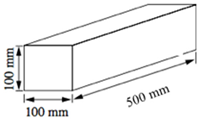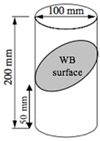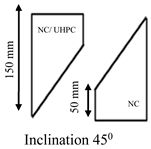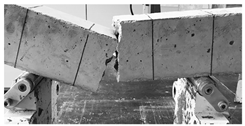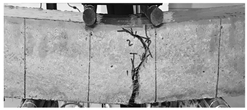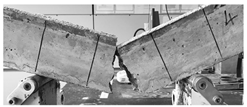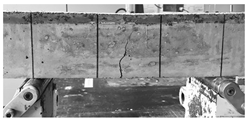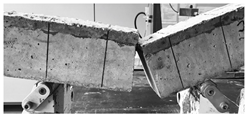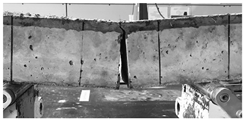Abstract
An estimate shows that approximately 50% of global annual construction activities account for the repair and retrofitting of structures and constructed facilities. Therefore, structural rehabilitation and repair are becoming hot topics among researchers, in order to find innovative and comprehensive solutions. Ultra-high-performance concrete (UHPC) is designed to achieve high strength and long-term durability. Such types of concrete offer a solution for complicated repair and retrofitting jobs. Although many benefits of using UHPC have been derived, many concerns have also been identified with the use of UHPC—sustainability is considered a critical concern due to the requirement of large proportions of cement, which results in an increase in cost and environmental impacts. This paper presents a recipe for UHPC that contains a small ratio of cement and a large proportion of fly ash, i.e., up to 50%, as a cement replacement material (CRM). In order to achieve long-term durability and increase bonding with old concrete or brickwork for repair and retrofitting purposes, ultra-fine calcium carbonate (UFCC) is also added. In selecting an appropriate material for structural repair, it is essential to acquire an understanding of the material behavior. Therefore, this research was focused on providing a comprehensive guide to the behavior and strength performance of UHPC. The experimental results have shown that the highest strength of UHPC with low cement content can be achieved using a binary combination of high-volume fly ash (HVFA) and ultra-fine CaCO3 (UFCC) as a substitution for cement by up to a ratio of 50% in the recipe. The UHPC with low cement content displayed excellent repair and retrofitting potential for structural strengthening in regions of high stress by developing a strong bond with the existing concrete substrate.
1. Introduction
The Transportation for America Report [1] highlighted that in the last four decades, a total number of 607,380 concrete bridges were found to be structurally deficient. On estimation, that is approximately 11% of the total number of constructed concrete bridges in the USA. Therefore, a comprehensive program for the reinstatement of such bridges has been rolled out. With the help of trends and statistics, by 2028, an estimated cost of $20.5 billion per year will be incurred through the rehabilitation, retrofitting, and replacement of deficient bridges in the USA [1]. Similarly, in the United Kingdom, the fraction of the maintenance cost of constructed facilities is continuously increasing in comparison to the construction cost of new facilities. A study predicted that the market size for the maintenance, repair, and improvement of built facilities would reach £28 billion, which will be 2.8 times larger than the size of the £10 billion markets for the construction of new facilities [2]. An analysis performed by Lam et al. [3] reported that from the beginning of 2002, approximately 50% of the activities conducted in the construction sector comprise structural maintenance jobs. In the Malaysian scenario, Kayan [4] highlighted that a significant number of buildings in Malaysia are deteriorating with time and urgently require maintenance and retrofitting programs. Between 2003 and 2005, the Malaysian Government increased its National Budget for building maintenance by 73% [5].
In the last 50 years, concrete has become the primary and most popular construction material in the world. The successful history of the application of concrete in many state-of-the-art structures was achieved by preparing the right recipe and specifications, adopting correct detailing, and paying due attention to supervision and quality control. In addition, an acceptable level of workmanship and routine maintenance can make concrete structures highly durable, reliable, and cost-effective [6]. However, in many cases, such criteria are not practiced well, particularly in medium- to low-level construction projects. As a consequence, many concrete structures are deteriorating before reaching their expected service life, and the number of concrete structures in this category keeps on increasing. For maintaining or reinstating the failing structures, rehabilitation or repair programs are necessary [1,2,3,4,5]. The literature shows that, in the past, many repaired and retrofitted concrete structures did not perform satisfactorily; almost 50% of them could not be sustained for over 10 years [7,8]. ]. When a repaired structure does not perform well, the possible reasons could be: a lack of engineering fundamentals, recommended guidelines are not followed, and incompatible materials are selected for the repair job. Since the beginning of this century, the deterioration and damage of concrete structures earlier than expected has become a hot issue in many parts of the world because this raises concerns around public safety, the rising cost of repair and retrofitting and the resulting pressure on the economy. Therefore, urgent attention needs to be paid to these concerns by developing an appropriate engineering approach to reduce the problem to a minimum level. At the same time, the primary functions and the adequacy of the structural capacity should be maintained. The frequency and extent of repair interventions should be kept at a minimum level, allowing only preventive maintenance without or with minimal service disruption [8,9].
Developing reliable and cost-effective repair materials that show high durability and comply with functional requirements is quite challenging [7]. The effectiveness and success level of such materials and techniques vary in terms of levels of satisfaction. In some cases, materials were initially found to be very useful, but later lost their level of satisfactory performance. Therefore, many repair systems did not perform well in the long term and were subject to premature failure. For example, to repair a bridge deck by applying a concrete overlay, it is mandatory that the overlay material must be compatible with the substrate material, and there must be a perfect bond between the new and old surfaces for the transmission of load within the system. The objective of the recent development of UHPC is that it should show extremely low permeability and outstanding mechanical properties. Therefore, UHPC can be considered an excellent candidate for the repair and rehabilitation of critical concrete structures, which are subjected to heavy mechanical loads and are exposed to the extreme surrounding conditions [10,11,12,13]. It has been observed that the majority of concrete structures that have undergone strengthening or rehabilitation are subjected to adverse loading and ambient conditions. Therefore, designing the most suitable rehabilitation system for a given job requires a comprehensive and performance-based approach that is able to avoid ineffective repair and maintenance that may lead to both money and material wastage [14].
The application of high-performance materials and innovative techniques plays a vital role in developing mechanical strength and enhancing the integrity and durability of the rehabilitated structure. It is recommended that the repair materials should have high fluidity and show higher compressive strength compared to the substrate concrete [15]. The dimensional behavior of the repair material concerning the substrate concrete is one of the challenging tasks in order to achieve the desired performance of the system throughout the service life. Differential dimensional changes cause the development of internal stresses between the repair material and the substrate. The possible effects of inducing high internal stresses include the development of tension cracks, loss of load-carrying capability, delamination, and deterioration. Special efforts are made to reduce internal stresses, and care must be taken in selecting appropriate materials that might be capable of maintaining dimensional compatibility and developing perfect bonds with the substrate material [12,16,17,18]. An experimental study conducted by Lee et al. [19] revealed the potential of UHPC as a repair material due to the high mechanical properties, fluidity, and bond strength exhibited. Also, UHPC showed very low creep and shrinkage properties. The extremely low porosity and intricated pore structure of UHPC resulted in low permeability and high durability. Therefore, the extraordinary attributes of UHPC make it a state-of-the-art material for the retrofitting of complex concrete structures subjected to extreme loading and ambient conditions.
For placing a concrete overlay on the old concrete substrate, concrete structures need homogeneity and continuity in the load flow pattern [20]. In this case, if the new concrete overlay develops low bond strength with the old concrete, a weak link in the repaired system will form, which requires an engineered solution [8,20]. Espeche and Leon [21] discussed two different mechanisms of developing the bond strength between two cementitious materials; one of the mechanisms is called adhesive bonding, which takes place at the micro-scale, and the other mechanism is known as cohesive bonding that occurs at the macro-scale. A perfect, strong, and durable bonding is the primary requirement of the long-lasting and successful repair system [17]. A study showed that good bond strength could be achieved by using Rapid Hardening Portland Cement in the new concrete against the old concrete; in this system, no bonding agent was used [22]. Momayez et al. [17] investigated the bond strength of new concrete-containing silica fume (SF) content that ranges from 0–10%. Their study concluded that the addition of SF in the overlay concrete showed significant improvement in the bond strength using four different techniques: pull-off, bi-surface shear, splitting prism, and slant shear. The most beneficial effects of SF were achieved using an optimum amount of 7%.
This study aimed to develop a green, sustainable, and cost-effective UHPC mix for possible application as a high-performing repair material. Therefore, in designing the mix proportions, it was intended to keep the cement content low by using high-volume fly ash (HVFA) up to 70%. It was anticipated that 70% FA content with 30% cement might cause negative impacts on the strength development at the early ages [23]. Therefore, it was required to address the issue of low strength development. In some studies, researchers have introduced different types of nanomaterials, such as titanium oxide (TiO2), zinc dioxide (ZnO2), calcium carbonate (CaCO3), silicon dioxide (SiO2), and carbon nanotubes to improve the early strength development of HVFA concrete [24,25,26,27]. However, the production of all these materials is highly energy-intensive, which impacts on the cost and environment [28]. Ultra-fine calcium carbonate (UFCC) composed of a mean particle size of 3.5 μm and produced consuming less energy, was considered an environmentally friendly material. Hence, UFCC was selected to compensate for the deficiency of using HVFA. It was expected that UFCC would enhance the characteristics of concrete mixes to a high-performance level by filling up the voids within the binder particles, rheological characteristics, and would form secondary hydration products through pozzolanic activity. Through seeding effects, UFCC can accelerate the hydration leading to an increased early strength [27,29,30,31]. The principal objective of the experimental study was to determine the optimum replacement of FA-UFCC in UHPC and to assess the characteristics of the optimum mixes as a high-performance repair material.
2. Experimental Program
2.1. Materials
For this experimental program, FA, SF, and UFCC were used as CRM; all these materials are locally produced. The Lafarge cement Malaysia supplied Portland Cement-I. Table 1 shows the chemical composition of all binding materials, which was analyzed using X-ray fluorescence technique (XRF). Scanning electron microscopy (SEM) images of all binders were taken to determine the morphological character and crystalline structure, which is shown in Figure 1. Crushed granite with a maximum size of 10 mm was used as coarse aggregate (CA), and river sand with a fineness modulus of 2.8 was used as the fine aggregate (FA). The CA to FA ratio was kept constant to 1.5 in all concrete mixes, refer to Table 3. Polycarboxylic Ether-based superplasticizer (SP) was used in all mixes. The straight steel fibers (SE) content of 1.0% by volume was used in this study for achieving ductility and post-cracking performance; the fiber properties are shown in Table 2.

Table 1.
The chemical composition of OPC, FA, SF, and UFCC using XRF analysis.
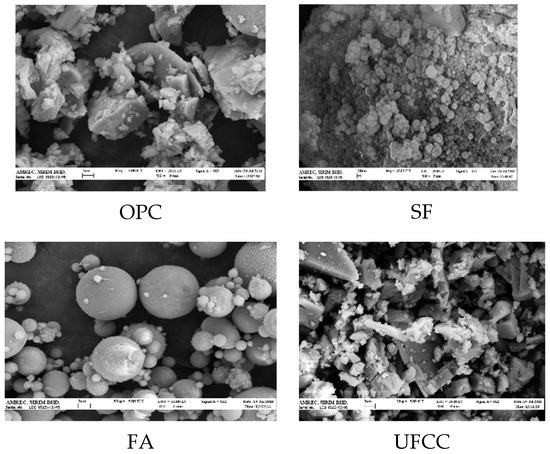
Figure 1.
SEM images of OPC, FA, SF, and UFCC.

Table 2.
Characteristics of steel fiber.
2.2. Proportioning and Preparation of Concrete Mixes
A total of 17 mix proportions were prepared, which were divided into three phases designated as A, B and C. The purpose of developing these mixes was to determine the optimum content of FA, SF, and UFCC for obtaining the highest possible response of UHPC. Details of the mix proportions are given in Table 3. For all concrete mixes, water to binder ratio (W/B) was kept constant to 16%; the dosage of SP varied from 1.5–4% for obtaining the desired workability.

Table 3.
UHPC mix proportions in kg/m3.
A 60-liter-capacity pan mixer was used for mixing purposes. All concrete mixes were mixed according to the procedure stated in Table 4. After casting the samples in the molds, they were covered using a plastic sheet to avoid any premature drying. After 24 h, samples were stripped out of molds and placed in the shelves for ambient curing (AC) at room temperature of 27 ± 2 °C until the time of testing.

Table 4.
UHPC mixing time.
2.3. Preparation and Curing of Samples for a Repair System
Evaluation of the bond strength between the deteriorated concrete substrate and the newly laid overlay is an essential characteristic for achieving the desired performance of the repair system. In some cases, for example, repairing a bridge deck, an overlay is cast for the reinstatement of the lost capacity of the deck. The overlay also protects the substrate against the ingress of any external agents such as chloride ions. In many cases, the overlay fails to perform the desired functions due to premature damages. One of the principal causes of damage in the repair system is the weak bond at the interface of the old and new surface that allows passage for moisture and ions ingress [10,32]. Therefore, specifying and assessing the bond strength of the concrete overlay at the interface of the old substrate is compulsory [17]. In this study, the bond strength of the UHPC overlay and the normal strength concrete (NC) substrate was investigated using slant shear testing method and the flexural test; testing and sample details are shown in Table 5.

Table 5.
Specimens used for observing the performance of UHPC as repair materials.
Samples were prepared in two stages; in the first stage, the concrete substrate (simulating to the existing part of the structure) was cast using grade-40 (which is the 28-day compressive strength) concrete designated as NC. Mix proportion details of NC are given in Table 6; all samples were cast and cured at room temperature. In stage two, after 28 days of curing, substrate samples were cut and underwent roughening operations. Proper surface preparation before the application of overlay materials is of critical importance to develop a strong and durable bond between the existing concrete substrate and the overlay material. Roughening treatment on the substrate surface was performed using a wire brush (WB) before overlay casting as recommended by Tayeh et al. [33]; Figure 2 shows the treated surface of a sample used in this study.

Table 6.
Mix proportion and compressive strength of NC substrate.
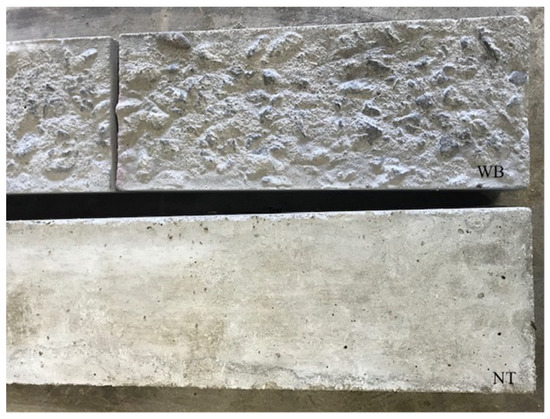
Figure 2.
Substrate before and after surface treatment.
For slant shear test, a composite cylinder of size 100 × 200 mm, as illustrated in Table 5, was used. These dimensions are slightly larger than the size recommended in ASTM C882 [34]. Different methods can be used in obtaining the inclined surface in the concrete substrate. ASTM C882 [34] recommended that the use of dummy sections that are made up of epoxy-resin mortar, fit the mold, and are equal to the one-half the volume of the specimen with an angle of 45° from vertical. Similarly, Piancastelli et al. [35] used oiled wooden-inserted steel-beam molds to form the slant surfaces in the substrate. Abu-Tair et al. [36] and BS EN 12615 [37] first cast the concrete specimens and later cut. In this study, specimens were cut to obtain an inclined surface. For casting the composite cylinders, the roughened NC substrates were then placed inside the molds in the position where the slanting side was facing upward and UHPC overlay was added, as shown in Figure 3. After casting, the composite cylinders were cured under ambient condition until the time of testing.
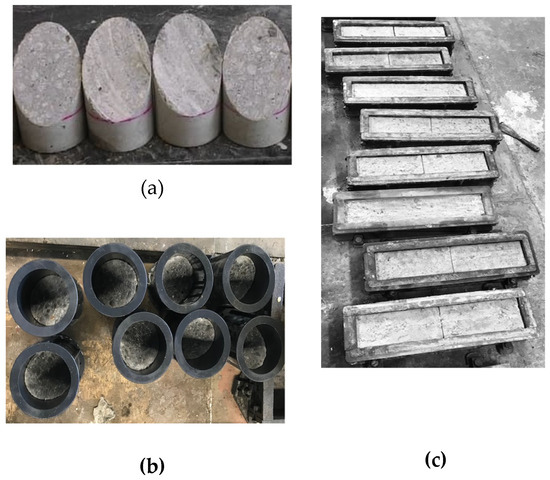
Figure 3.
NC substrate prior to overlaying of UHPC: (a) slant cur cylindrical samples; (b) cylindrical molds (c) notched samples in the molds.
For flexural strengthening and fracture testing, the composite beam specimens with sizes of 100 × 100 × 500 mm were cast. The notch on the beam for fracture testing was obtained by cutting the specimens into one-halves using a concrete cutter. Beam specimens were cast with and without UHPC overlay-material: the overlay thickness was 15 and 20 mm. Before the overlay casting, the surface of the roughened NC substrates was moistened for 10 min and then wiped; which was intended to create a saturated surface dry condition (SSD). SSD condition is required for avoiding the water film on substrate surfaces, which may reduce the bond strength between two concrete materials [38].
The slant shear and flexural tests were performed at the age of 28 days after casting of the composite samples. For this study, mix type MF30U10 was selected for overlay. The selection was made based on the results of the overall compressive strength and its pozzolanic strength index (PASI) value.
2.4. Compressive Strength Test
Concrete compressive strength of non-composite specimens with cube sizes of 100 mm was determined according to the procedure described by BS EN 12390-3 [39]. Compressive strength test was conducted at the age of 7, 28, and 90 days. Three specimens were tested for each mix at every age of testing. The test was performed at a constant loading rate of 3.0 kN/s.
2.5. Slant Shear Test
The slant shear test was performed according to the procedure prescribed by ASTM C882 [34], which is a widely accepted method and recommended by many codes of practices and standards for assessing the bond strength of the layered samples [40]. The test was performed at a constant loading rate of 3.0 kN/s. As discussed above in Section 2.3, UHPC was overlaid on the vertically-inclined-at-45° slant plane of the NC substrate specimens to form the composite cylinder specimens of dimensions 100 × 200 mm as shown in Figure 3. The bond strength was calculated using Equation (1) as follows:
where S is the bond strength (MPa), P is the maximum force recorded (N), and AL is the area of the slant surface (mm2). In this case, the slant surface area can be taken as a nominal value of π × (100/2) × ((100/cos 45°)/2) = 11,107 mm2.
2.6. Flexural Strengthening and Fracture Test
Flexural strength test was performed by applying a four-point loading configuration, which consisted of two supporting rollers (end supports) and two upper rollers held by the articulated cross member. The testing procedure complied with the requirements of BS EN 12390-5 [41]. The beam was placed evenly on the supporting roller 300 mm apart. The load was applied at a constant rate of 0.2 kN/s continuously until failure. The maximum load and crack pattern were measured and recorded. Flexural strength was calculated using Equation (2).
where fcf is the flexural strength (MPa); F is the maximum force recorded (N), L is the distance between supporting rollers (mm), and d1 and d2 are the lateral dimensions of the specimen (mm).
For evaluating the fracture performance of the composite structure, the four points bending test was conducted on notched specimens. In the preparation of the test sample, a substrate was cast by creating a through-notch as shown in Figure 4a. The purpose of creating a through-notch was for simulating the crack in the actual structure (the old concrete substrate before laying the overlay).
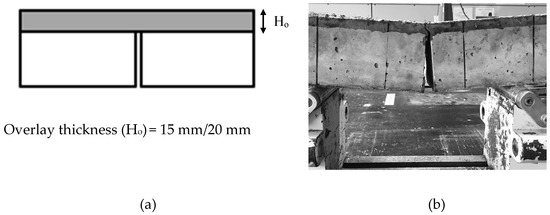
Figure 4.
Flexural test on the notched specimen: (a) illustration of a notched substrate with overlay; (b) tested notched sample with overlay in the laboratory.
3. Results and Discussions
3.1. Compressive Strength Test
As the first objective of this research was to achieve high compressive strength of the UHPC using low cement content and HVFA for complying with the aspiration for sustainable development goals. HVFA was selected based on a variety of benefits experienced by many researchers: it reduces the water demand, improves the workability, minimizes the thermal cracking and drying shrinkage, reduces the chances of reinforcement corrosion, and controls sulfate attack and alkali-silica expansion [42]. Figure 5 shows the results of the compressive strength and PASI of all concrete mixes determined at the age of 7, 28, and 90 days. PASI was used to evaluate the pozzolanic activity of cement-based composite. The PASI is defined as the ratio of the compressive strength of blended cement concrete in which up to 70% of Portland cement is replaced by pozzolan to the compressive strength of a reference concrete (pure cement) under the same curing conditions. Figure 5a shows the results of concrete mixes of phase-A, which are FA-based mixes. It can be observed that with the increase in the FA content (30–70%), there is a reduction in strength at an early age. The reduction of PASI with the increase of FA percentage can be represented in a sharp downward linear trend with correlation coefficients (R2) of over 0.9. The reduction in both strength and PASI of phase-A concrete was due to a reduction in the heat of hydration, which slowed down the setting time that caused a reduction in the early age strength.
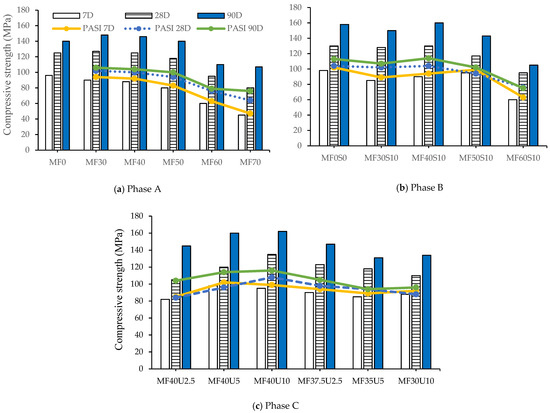
Figure 5.
Compressive strength at different concrete ages for Phase A, B, and C.
Concrete mix prepared in phase-B contained FA and 10% SF; when the cement was replaced with 70% FA in mix MF70, the 7-day compressive strength was obtained as 45 MPa; on the other hand, concrete mix MF60S10 that replaced 70% cement with 60% FA plus 10% SF showed 7 days strength as 60 MPa, which is 25% higher than the strength of MF70. In general, concrete mixes in phase-B showed 12–58% higher compressive strength than the corresponding concrete mixes in phase-A. This phenomenon can be explained by the dispersion of cement grains, which leads to improved gel phase development [29]. In phase-A mixes, the highest 28-day strength was obtained as 127 MPa (MF30) and highest 28-day strength of phase-B was obtained as 130 MPa (M40S10). The PASI value at 28 days for phase-A and phase-B was seen in a downward trend after mix MF50 and mix MF40S10, respectively.
Concrete mixes of phase-C contained UFCC (2.5–10%) together with FA; the significance of adding UFCC was obtained at the early age strength; all mixes in this phase showed over 80 MPa strength at the age of 7 days, which is considered quite high early strength. The highest 7-day compressive strength was obtained as 95 MPa of the mix MF40U10 with a PASI value of 94%; the same mix showed the highest 28-day strength and PASI as 135 MPa and 104%. It indicates the effectiveness of UFCC in offsetting the low strength at the early age of HVFA. With the increase of age, the strength of UHPC with FA-UFCC combination increased rapidly. The compression strength of UHPC with only FA (50% replacement) was 140 MPa at 90 days; this value was gradually increased by about 16% to 160 MPa when 10% of UFCC was incorporated and combined with 40% FA. Higher compressive strength value for the FA-UFCC combination indicates the effectiveness of UFCC in offsetting the low strength of UHPC-containing HVFA at a later age. The 90-day PASI value was the highest for mix MF40U10; the value then showed a downward trend with a lowest PASI value of 94%.
The strength enhancement due to the inclusion of UFCC in UHPC-containing HVFA is acceptable when compared to results obtained by Refs. [25,27,29,43]. In their studies, they explained that the inclusion of nano-CaCO3 improves the microstructure by forming additional C–S–H gels and decreases the CH and Ca2SiO4 of HVFA concretes. Not only that, the CaCO3 powder led to a much denser microstructure, but it is also responsible for changing the formation of the hydration products which contributed to the improvement of early age and later age compressive strength and durability properties. UFCC has high reactivity and active filler effects in reducing the pore space and its connectivity inside the concrete [29].
3.2. Slant Shear Strength
Slant shear test is an important test that helps to develop the right strategy for repairing an inclined substrate, which is quite complicated. With this test, the designer can assess the quality of the bond material and bonding process. During testing of the composite cylinder, the failure in the substrate will be an indication that the interfacial bond zone is stronger than the substrate, which may be used to qualify the bond material for the repair job. On the other hand, if the interfacial bond zone fails during the test, this means that the bond material and configuration is weaker than the substrate material. In general, it is preferred that for any repair job, the bond zone should be either of the same strength as the substrate or stronger than the substrate. In this testing program, failure of all samples was visually examined for classifying the type of failure, such as bond failure, substrate failure, overlay failure, or combination of different modes. Table 7 shows the recommended values of the bond strength as specified in the American Concrete Institute (ACI) document titled, Guide for the Selection of Materials for the Repair of Concrete [44]. These values are considered as the minimum acceptable bond strength. Table 8 shows 28-day slant shear test results performed in this research study. The bond strength of different samples was estimated using Equation (1).

Table 7.
The recommended minimum value for bond strength [44].

Table 8.
Slant shear strength at 28 days and failure mode of different material combinations.
Figure 6 illustrates two possible types of failure modes that can happen: interface failure and substrate failure. The experimental results showed that the interfacial bonding of all UHPC/NC specimens was quite a bit stronger than that of the substrate; almost in all cases, the failure happened in the substrate, whereas the interfacial zone remained intact; no separation or debonding was observed. It can be generalized that when UHPC overlay materials are used for repairing the damaged substrate, most likely a Type B failure mode occurs. In the cases where both substrate and overlay are made of normal-strength concrete, usually, Type-A failure occurs. The mean bond strength for UHPC/NC specimens was obtained at 105% higher than that of the NC/NC specimens. The significant enhancement could generally be attributed to more excellent adhesion and interlocking between the UHPC and the roughened NC substrate surfaces. The roughened surface with exposed aggregates developed superior adhesion with excellent interlocking with the UHPC overlay. It contributed to the exceptional interfacial shear bond strength of the composite. The synergy of HVFA, together with UFCC, is shown in improving the transition zone in concrete through the micro-filler effect, and due to excellent pozzolanic activity [45,46,47,48]. It could also be the reason that the roughed and textured surface of the substrate supplied the source of CH for initiating the spontaneous pozzolanic reaction. Hence, it could have established a mechanical bond as well as a chemical bond at the interface of the composite; such a mechanism can be classified as a ‘‘mechano-chemical’’ bond [33].
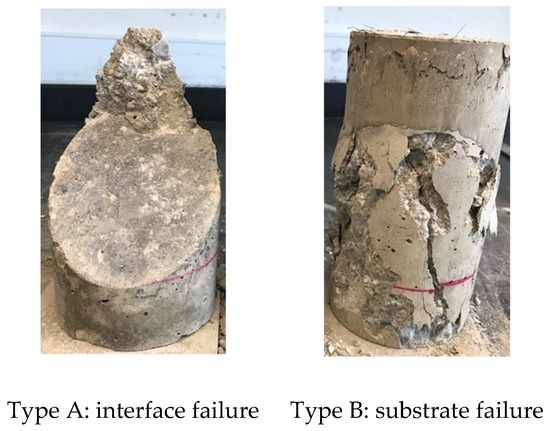
Figure 6.
Failure modes for the slant shear test.
As stated in the ACI Concrete Repair Guide [44], a specified minimum acceptable bond strength based on the slant shear strength should be specified for designing the repair material. So, this guide is considered a useful document for designing the material and configuration for repair and retrofitting of a damaged concrete substrate. Referring to these guidelines, all the specimens tested in this study complied with the requirements of minimum bond strength. The bond strength results of the slant shear test show that the bond between UHPC/NC has an excellent performance. The bond strength of UHPC/NC samples at the age of 28 days exceeded the requirements as specified by ACI 546R-04. Tayeh et al. [33] reported that the bond strength for concrete repair without any treatment was far lower than the recommended value. They found that the surface preparation of concrete mostly controlled the development of adhesion and the bond strength. Besides bond strength, the normalized shear strength results were also considered. The normalized shear strength results shown in column 5 of Table 8 indicate that UHPC has twice the shear resistance as NC. It means that structural elements that are subjected to high shear could be strengthened with UHPC. The COV varies from 1.0 to 5.8%; hence, the test can be considered consistent.
3.3. Flexural Strength
In the current practices, retrofitting and strengthening of the damaged structural member is continuously increasing. The basic principle of retrofitting is treating a damaged structural member for reinstating it to the original design strength level. The superior ductility and durability characteristics of UHPC allow it to be used as an alternative to conventional concrete overlay materials [49]. In this section, the effectiveness of UHPC as an overlay and the behavior of damaged NC beam retrofitted with UHPC overlay was studied. NC beams of length 500 mm, width 100 mm and depth 100 mm were cast using grade-40 concrete in the laboratory and cured under ambient temperature for 72 days before the UHPC was laid on top of it. These composite specimens will be cured under ambient temperature for another 28 days before testing, making the total age of concrete substrates during testing be 100 days. In this study, the four-point bending test was used, and a total of 30 beams were cast. Each result indicated below was from an average of three specimens. NC beams cast without any retrofitting material were taken as control specimens. Notched layered beams were used in order to simulate a possible evolution of crack, which can result from restrained shrinkage between the substrate and the overlay material. The damaged beams were retrofitted with UHPC overlays on top of the substrate with 15-mm and 20-mm-thick layers to find its optimum. Results obtained were compared with the control beam. The flexural strength of composite structures on both un-notched and notched beams is shown in Table 9.

Table 9.
Flexural strength results on un-notched and notched beams.
The effects of flexural strengthening with UHPC bonding at 15-mm and 20-mm thickness on un-notched beams were higher than NC control specimens by 37.5% and 40%, respectively. The flexural strength of these composite materials was also higher than specimens with NC overlay by about 55% and 60% respectively for NC overlay thicknesses of 15 mm and 20 mm. The increase of UHPC overlay thickness from 15 mm to 20 mm influenced the flexural strengthening by about 13%. These findings were similar to the previous study performed by Lee et al. [12,50]. Their results indicated that the use of a 10-mm-thick UHPC bonding layer is sufficient to increase both compressive and flexural strengths. The flexural strength for the composite beam with 10-mm UHPC overlay was improved by 54% from 4.7 MPa (NC specimen) to 7.2 MPa at 7 days. Also, the abrasion resistance of a UHPC overlay was reported to be approximately eight times higher than that of the NC overlay.
On the other hand, specimens with notched substrates show little flexural strength. When similar NC was used as an overlay, the flexural strength recorded on notched beams was between 0.3 and 0.4 MPa. Flexural strength was, however, improved with the application of UHPC overlays. UHPC overlays with thickness heights of 15 mm and 20mm significantly improved the fractured flexural strength at 330 and 333% compared to specimens strengthened with NC. Earlier studies on the flexural behavior of UHPC as overlays have reported the optimum overlay height that ranges between 10 to 45 mm. After varying the numbers of rebar and fiber volumes, Yuguang et al. [51] reported that a 30-mm-thick UHPC overlay made without any rebar could endure the maximum traffic load. Besides the flexural strength, it is also clear that UHPC overlays change the failure mode of composite beams. The presence of fibers prevents composite beams from experiencing sudden brittle failure. Composite beams with UHPC strengthening were seen to be intact at failure with interface cracking.
4. Conclusions
- This study concluded, that with the 50% replacement of cement with 40% FA and 10% UFCC together with 1% steel fibers using very low W/B (0.16), 28-day concrete strength was achieved as 135 MPa whereas at the age 90 days it was obtained as 162 MPa. Due to the dilution effect of using a large amount of FA, the hydration of cement was delayed and was compensated with the addition of 10% UFCC content, which enhanced the 7-day compressive strength to 25%.
- This study was focused on developing a high-performance repair material with a low carbon footprint; it was evaluated by conducting a series of slant shear and flexural tests. The mean bond strength of all UHPC/NC specimens was obtained higher than the minimum bond strength recommended by ACI Concrete Repair Guide.
- The dominant failure mode in the slant shear test was the normal concrete substrate failure mode, which indicates a strong interfacial bond between the UHPC overlay and the substrate. This type of failure is considered a preferred mode of failure for high-performance repair systems.
Author Contributions
N.M.A. has conducted the experimental research, performed data analysis, and prepared the manuscript draft. N.S. has supervised the research, review the results and corrected the manuscript.
Funding
This research received no external funding.
Acknowledgments
The authors would like to acknowledge Universiti Teknologi PETRONAS, Malaysia, for sponsoring this research work. The authors also wish to thank Soo Sin Quan, BEng student of Universiti Teknologi PETRONAS, for his assistance in carrying out some of the experimental work in this research.
Conflicts of Interest
The authors declare no conflict of interest.
References
- Transportation for America. Transportation for America Report (TAR). The Fix That We Are in for: The State of Our Nation’s Bridges 2013; Transportation for America: Washington, DC, USA, 2013. [Google Scholar]
- Wood, B. Towards Innovative Building Maintenance. Struct. Surv. 2005, 23, 291–297. [Google Scholar] [CrossRef]
- Lam, E.W.M.; Chan, A.P.C.; Chan, D.W.M. Benchmarking success of building maintenance projects. Facilities 2010, 28, 290–305. [Google Scholar] [CrossRef]
- Kayan, B. Maintaining old building during post gazetted period-case study: Kuala Lumpur, the Malaysian surveyor. J. Inst. Surv. Malaysia 2006, 40, 15–22. [Google Scholar]
- Noor, N.M.; Hamid, M.Y.; Ghani, A.A.A.A.; Haron, S.N. Building Maintenance Budget Determination: An Exploration Study in the Malaysia Government Practice. Procedia Engineering. 2011, 20, 435–444. [Google Scholar] [CrossRef][Green Version]
- International Concrete Repair Institute. International Concrete Repair Institute Report: A Vision for Concrete Repair, Protection, and Strengthening Industry; Vision 2020; International Concrete Repair Institute: St Paul, MN, USA, 2006. [Google Scholar]
- Tilly, G.P.; Jacobs, J. Concrete Repairs: Observations on Performance in Service and Current Practice; CONREPNET Project Report; IHS BRE Press: Watford, UK, 2007. [Google Scholar]
- Bruhwiler, E.; Denarie, E. Rehabilitation of Concrete Structures Using Ultra-High Performance Fiber Reinforced Concrete. In Proceedings of the 2nd International Symposium on Ultra-High Performance Fiber-Reinforced Concrete, Kassel, France, 5–7 March 2008; pp. 895–902. [Google Scholar]
- Mather, B.; Warner, J. Why Do Concrete Repairs Fail? Interview Held at the University of Wisconsin; Madison Engineering Professional Development: Madison, WI, USA, 2003. [Google Scholar]
- Li, V.C.; Horii, H.; Kabele, P.; Kanda, T.; Lim, Y.M. Repair and retrofit with engineered cementitious composites. Eng. Fract. Mech. 2000, 65, 317–334. [Google Scholar] [CrossRef]
- Denarie, E.; Brühwiler, E. Structural rehabilitations with ultra high performance fibre reinforced concretes. Int. J. Restor. Build. Monum. 2006, 12, 453–467. [Google Scholar]
- Lee, M.G.; Wang, Y.C.; Chui, C.T. Preliminary study of RPC as new repair material. Constr. Build. Mater. 2007, 21, 182–189. [Google Scholar] [CrossRef]
- Bruhwiler, E. Rehabilitation and Strengthening of Concrete Structures Using UHPFRC. In Concrete Repair, Rehabilitation and Retrofitting; Taylor Francis Group: London, UK, 2012; Volume 3. [Google Scholar]
- Liu, C.T.; Huang, J.S. Highly Flowable Reactive Powder Mortar As Repair Material. Constr. Build. Mater. 2008, 22, 1043–1050. [Google Scholar] [CrossRef]
- Xiong, G.; Liu, J.; Li, G.; Xie, H. A Way for Improving Interfacial Transition Zone Between Concrete Substrate and Repair Materials. Cem. Concr. Res. 2002, 32, 1877–1881. [Google Scholar] [CrossRef]
- Wang, Y.C.; Lee, M.G. Ultra-High Strength Steel Fiber Reinforced Concrete for Strengthening of RC Frames. J. Mar. Sci. Technol. 2007, 15, 210–218. [Google Scholar]
- Momayez, A.; Ehsani, M.R.; Ramezanianpour, A.A.; Rajaie, H. Comparison of methods for evaluating bond strength between concrete substrate and repair materials. Cem. Concr. Res. 2005, 35, 748–757. [Google Scholar] [CrossRef]
- Harris, D.K.; Sarkar, J.; Ahlborn, T.M. Interface bond characterization of ultra-high-performance concrete overlays. In Proceedings of the Transportation Research Board 90th Annual Meeting, Washington, DC, USA, 23–27 January 2011. [Google Scholar]
- Denarie, E.; Bruhwiler, E.; Znidaric, A. Full-Scale Applications of UHPFRC for the Rehabilitation of Bridges-From the Lab to the Field-Deliverable D22. WP14:HPFRCC (High-Performance Fiber-Reinforced Cementitious Composites) for Rehabilitation, Sustainable and Advanced MAterials for Road InfraStructure (SAMARIS); SAMARIS Corporation: Laussane, Switzerland, 2005. [Google Scholar]
- Li, M.; Li, V.C. Behavior of ECC/concrete layer repair system under drying shrinkage conditions. J. Restor. Build. Monum. 2006, 12, 143–160. [Google Scholar]
- Espeche, A.D.; Leon, J. Estimation of bond strength envelopes for old-to- new concrete interfaces based on a cylinder splitting test. Constr. Build. Mater. 2011, 25, 1222–1235. [Google Scholar] [CrossRef]
- Climaco, J.C.T.S.; Regan, P.E. Evaluation of bond strength between old and new concrete in structural repairs. Mag. Concr. Res. 2001, 53, 377–390. [Google Scholar] [CrossRef]
- Babu, K.G.; Rao, G.S.N. Efficiency of fly ash in concrete with age. Cem. Concr. Res. 1996, 26, 465–474. [Google Scholar] [CrossRef]
- Jayapalan, A.R.; Lee, B.Y.; Kurtis, K.E. Can nanotechnology be ‘green’? Comparing efficiency of nano and microparticles in cementitious materials. Cem. Concr. Compos. 2013, 36, 16–24. [Google Scholar] [CrossRef]
- Kawashima, S.; Hou, P.K.; Corr, D.J.; Shah, S.P. Modification of cement-based materials with nanoparticles. Cem. Concr. Compos. 2013, 36, 8–15. [Google Scholar] [CrossRef]
- Yang, H.; Che, Y.; Leng, F. High volume fly ash mortar containing nano-calcium carbonate as a sustainable cementitious material: Microstructure and strength development. Mater. Sci. Rep. 2018, 8, 164393. [Google Scholar] [CrossRef] [PubMed]
- Cao, M.; Ming, X.; He, K.; Li, L.; Shen, S. Effect of macro-, micro-, and nano-calcium carbonate on properties of cementitious composites. Materials 2019, 12, 781. [Google Scholar] [CrossRef]
- Hemalatha, T.; Mapa, M.; George, N.; Sasmal, S. Physico-chemical and mechanical characterization of high volume fly ash incorporated and engineered cement system towards developing greener cement. J. Clean. Prod. 2016, 125, 268–281. [Google Scholar] [CrossRef]
- Shaikh, F.; Supit, S.; Sarker, P. A study on the effect of nano-silica on compressive strength of high volume fly ash mortars and concretes. Mater. Design 2014, 60, 433–442. [Google Scholar] [CrossRef]
- Supit, S.; Shaikh, F.U.A.; Sarker, P.K. Effect of nano-silica and ultrafine fly ash on compressive strength of high volume fly ash mortar. Appl. Mech. Mater. 2013, 368–370, 1061–1065. [Google Scholar] [CrossRef]
- Supit, S.; Shaikh, F.U.A. Mechanical and durability properties of high volume fly ash concrete containing calcium carbonate nanoparticles. Constr. Build. Mater. 2014, 70, 309–321. [Google Scholar]
- Krauss, P.; Lawler, J.; Steiner, K. Guidelines for Selection of Bridge Deck Overlays, Sealers, and Treatments; Wiss, Janney, Elstner Associates, Inc.: Northbrook, IL, USA, 2009. [Google Scholar]
- Tayeh, B.A.; Bakar, B.H.A.; Johari, M.A.M.; Voo, Y.L. Mechanical and permeability properties of the interface concrete substrate and UHPC overlay. Constr. Build. Mater. 2012, 36, 538–548. [Google Scholar] [CrossRef]
- American Society for Testing and Materials. ASTM C 882. Standard Test Method for Bond Strength of Epoxy-Resin Systems Used with Concrete By Slant Shear; American Society for Testing and Materials: West Conshohocken, PA, USA, 2005. [Google Scholar]
- Piancastelli, E.M.; Magalhães, A.G.; Silva, F.J.; Rezende, M.A.P.; Santos, W.J.; Carrasco, E.V.M.; Mantilla, J.N.R. Bond Strength between Old and New Concretes with Focus on the Strengthening of Reinforced Concrete Columns—Slant Shear Test versus Double Sleeve Test. Appl Mechanics Materials 2017, 864, 324–329. [Google Scholar] [CrossRef]
- Abu-Tair, A.I.; Rigden, S.R.; Burley, E. Testing the bond between repair materials and concrete substrate. ACI Mater. J. 1996, 93, 553–558. [Google Scholar]
- European Committee for Standardization. BS EN12615, Products and Systems for the Protection and Repair of Concrete Structures. Test Methods. Determination of Slant Shear Strength; European Committee for Standardization CEN: Brussels, Belgium, 1999. [Google Scholar]
- Omar, B.; Fattoum, K.; Maissen, B.; Farid, B. Influence of the roughness and moisture of the substrate surface on the bond between old and new concrete. Contemp. Eng. Sci. 2010, 3, 139–147. [Google Scholar]
- European Committee for Standardization. BS EN 12390-3, British Standard Part 3: Testing Hardened Concrete. Compressive Strength of Test Specimens; European Committee for Standardization CEN: Brussels, Belgium, 2009. [Google Scholar]
- Pedro, M.D.S.; Eduardo, N.B.S.J. Assessment of the shear strength between concrete layers. In Proceedings of the 8th fib PhD Symposium in Kgs, Lyngby, Denmark, 20–23 June 2010. [Google Scholar]
- European Committee for Standardization. BS EN 12390-5, British Standard Part 5: Testing Hardened Concrete. Flexural Strength of Test Specimens; European Committee for Standardization CEN: Brussels, Belgium, 2009. [Google Scholar]
- Yu, R.; Spiesz, P.; Brouwers, H.J.H. Development of ultra-high performance fibre reinforced concrete (UHPFRC): Towards an efficient utilization of binders and fibres. Constr. Build. Mater. 2015, 79, 273–282. [Google Scholar] [CrossRef]
- Huang, Z.; Cao, F. Effects of nanomaterials on the performance of UHPC. Mater. Rev. 2012, 26, 136–141. [Google Scholar]
- American Concrete Institute. ACI Committee 546R. Guide to Concrete Repair; American Concrete Institute: Farmington Hills, MI, USA, 2014. [Google Scholar]
- Ferdosian, I.; Camoes, A. Eco-efficient UHPC Development by Means of Response Surface Methodology. Cem. Concr. Compos. 2017, 84, 146–156. [Google Scholar] [CrossRef]
- De Weerdt, K.; Kjellsen, K.O.; Sellevold, E.; Justnes, H. Synergy between fly ash and limestone powder in ternary cements. Cem. Concr. Compos. 2011, 33, 30–38. [Google Scholar] [CrossRef]
- Amankwah, S.A.; Zajac, M.; Stabler, C.; Lothenbach, B.; Black, L. Influence of limestone on the hydration of ternary slag cements. Cem. Concr. Res. 2017, 100, 96–109. [Google Scholar] [CrossRef]
- Lothenbach, B.; le Saout, G.; Gallucci, E.; Scrivener, K. Influence of limestone on the hydration of Portland cements. Cem. Concr. Res. 2008, 38, 848–860. [Google Scholar] [CrossRef]
- Sahmaran, M.; Yucel, H.E.; Yildrim, G.; Al-Emam, M.; Lachemi, M. Investigation of bond between concrete substrate and ECC overlays. J. Mater. Civ. Eng. 2014, 26, 167–174. [Google Scholar] [CrossRef]
- Yuguang, Y.; Uijl, J.D.; Walraven, J. Study on Bending Behavior of an UHPC Overlay on a Steel Orthotropic Deck. In Second International Symposium on Ultra High Performance Concrete; Kassel University Press: Kassel, Germany, 2008; pp. 639–646. [Google Scholar]
- Shafiq, N.; Nuruddin, M.F.; Kamaruddin, I. Comparison of engineering and durability properties of fly ash blended cement concrete made in UK and Malaysia. Adv. Appl. Ceram. 2007, 106, 314–318. [Google Scholar] [CrossRef]
© 2019 by the authors. Licensee MDPI, Basel, Switzerland. This article is an open access article distributed under the terms and conditions of the Creative Commons Attribution (CC BY) license (http://creativecommons.org/licenses/by/4.0/).
